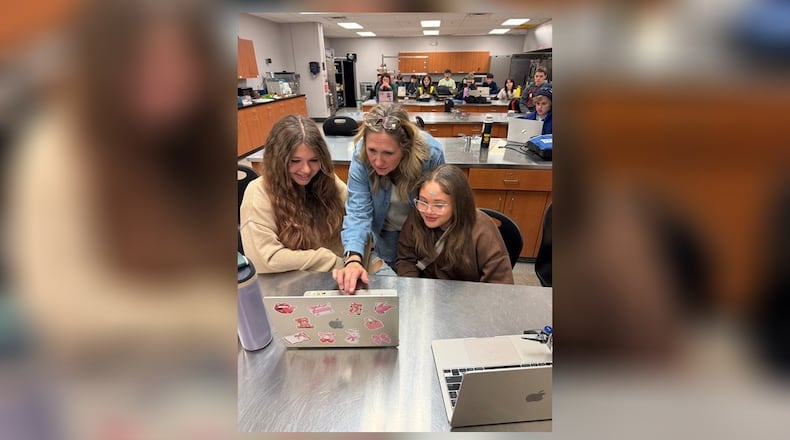VFT offers both live streams and on-demand content, the difference being that live streams are broadcasting video and audio content in real time over the internet while an event is happening. On-demand content describes videos that have already been produced and can be watched in their entirety at any time.
“We knew when we developed this program over a decade ago that we were trying to replicate the in-person experience that students get when they travel to a farm and they see agriculture happen in person when they experience a conversation with a farmer. We wanted to bring that to life as much as we could, (and) we think this is a great way that people can connect with students,” said Melanie Flax Wilt, founder and CEO of Shiftology.
Shiftology, along with VFT and support from Ohio State University’s College of Food, Agricultural and Environmental Sciences (CFAES), recently held a webinar called “Improving Ag Literacy with Virtual Experiences” that talked about VFT, how effective they are and how they can help students.
Nicole Volk, doctoral student at the CFAES Department of Agricultural Communication, Education and Leadership, said VFTs are a “really great option” for teachers because they are a low or no cost alternative to a traditional field trips, require a lot less time away from the classroom and need fewer logistics because you don’t have to worry about permission slips, busing or figuring out schedules.
“A VFT has a lot more reach than a single traditional field trip. You have the opportunity to reach hundreds of students with one offering and get them to places that they probably can’t or you don’t want them on a field trip,” she said. “A VFT is right there within the classroom.”
VFTs also present an alternative when maybe school budgets don’t allow for a traditional field trip, she said.
Understanding the food system
Volk spoke about a system-based approach, which can help improve students’ food literacy and their understanding how the different pieces work. and
The system-based approach can influence their attitudes and behaviors toward the overall food chain, Volk said, and inspire inquiry-based learning, which focuses on developing scientific thinking to have students think about the process, ask questions and reflect on the knowledge.
“We know, especially in agriculture, that a lot of children don’t understand the food system. Their knowledge of where food comes from may by just the grocery store,” she said.
Volk said inquiry-based learning pairs well with VFT because it “encourages that engagement, gets them excited and willing and interested in learning.”
“We want students to be thinking about being educated and taking these field trips into their classrooms. They’re already in an environment where they know they’re there to learn, whereas a field trip might just be a fun day that you get out of the classroom. This is something that broadcasts right into a space they’re already comfortable in and they’re primed to learn,” she said.
Local STEM school taking up VFT
Global Impact STEM Academy teachers have previously participated in VFT, especially during COVID, but teacher Andrea Keener said she recently signed up to participate one. Greenon Local Schools had teachers participate during COVID, while Springfield City and Clark-Shawnee Local schools do not participate.
Wilt said teachers have shared they would recommend the virtual trips because they align with the curriculum and provide a much-needed break in the school year, offering an engaging way to keep students interested.
Keener signed up for the Soybean Field Harvest ride along, and she plans to use the recorded session, but has not used it in class yet. For this one, once you sign up, you get the link to watch live during a specified time.
She said her classes studied soybeans a little bit at the beginning of the year and made soy milk from the beans as a food science project.
“I think they (VFT) definitely could show kids things that they may never get the opportunity to see in person, especially for this particular one since you can’t have an entire class of seventh graders ride in a combine during harvest,” she said. “I think seeing this process of how soybeans are harvested could add another layer to their learning about the subject.”
In-person experiences vs. virtual convenience
While a live stream maybe give students a look at places they may not be able to go on an in-person trip, teachers still see value in traditional field trips.
“Experience is what kids will remember, what will stake claim in their brains and memories, so to speak. Videos are coming at them at rapid rates these days and I think just watching the VFT can be like another reel they scroll through,” said Keener while explaining why she thinks real life experiences are better.
Although the virtual trip may be helpful and can add value, Keener thinks the time frame for a live stream is hard if you’re not in an elementary classroom. She said she has six periods a day every 50 minutes so showing a live stream to all her classes is not possible, unless it’s in a large group setting, which isn’t ideal.
One of the reasons Wilt said why they do these VFT is because it helps with the challenges teachers may face with traditional ones, such as getting the kids together for the trip, number of kids you can take and how many you have per one teacher, permission slips and discipline.
“It makes a lot of sense to be able to provide this because they have the opportunity then to have more of a kind of captive audience that actually helps with being able to deliver the content in a way that doesn’t have all of these other obstacles or distractions around them,” she said.
Dan Toland, director of virtual experiences for VFT, said it’s neat being a part of it.
“You talk about a direct way to help increase demand for your products when you can connect the dots between what’s going in the field and what’s ending up on their plate and how it all gets there and excite them about that. I mean, that’s a home run. That’s a slam dunk reaching thousands of kids at a time with one trip,” he said.
About the Author


